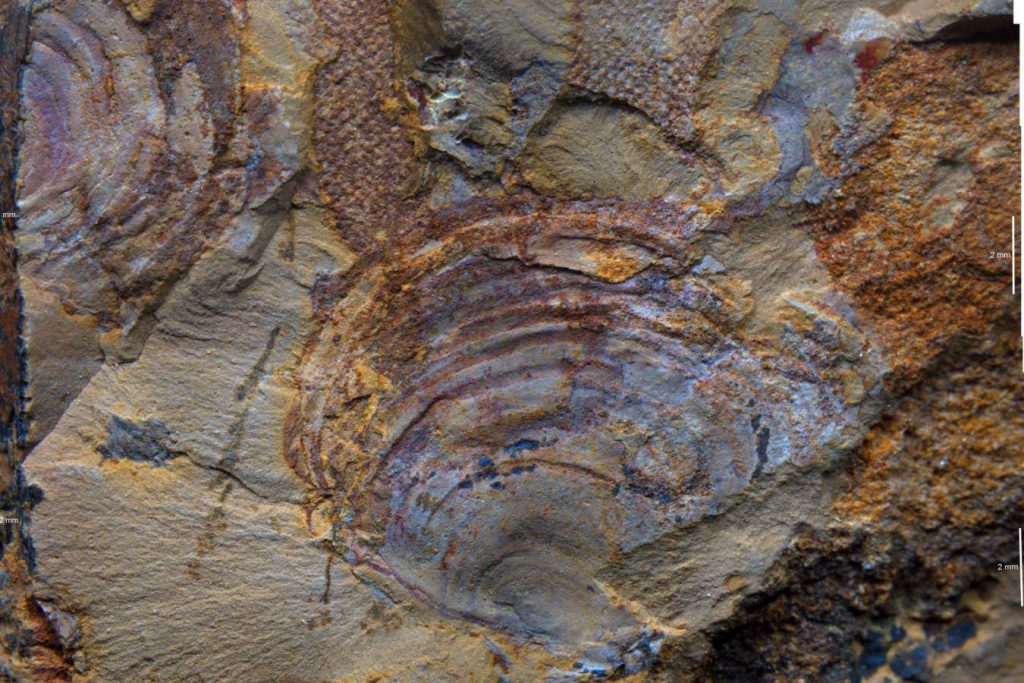A fossil of a brachiopod shell, centre, with Protomelission attached to it, above, which was part of the new study
Zhang Xiguang
A 515-million-year-old fossil once thought to be the earliest known animal from a group called the bryozoans might actually be a seaweed.
Bryozoans, commonly called moss animals, are tiny, coral-like creatures that live in colonies in oceans and freshwater.
Nearly all major animal groups first appear in the fossil record between 541 and 520 million years ago during an evolutionary event known as the Cambrian explosion. Until two years ago, the bryozoans were the only animal group missing from that event: the earliest fossil traces of bryozoans dated to 40 million years after it.
Advertisement
But in 2021, Paul Taylor at the Natural History Museum in London and his colleagues identified the Cambrian fossil Protomelission gatehousei, unearthed in Australia and China, as a bryozoan – suggesting these animals didn’t arrive on the scene much later than other groups after all.
Now, Martin Smith at Durham University, UK, and his colleagues have studied 12 new Protomelission-like fossils from Kunming in China, which underwent a form of preservation that maintained their soft tissues.
The team found clumping formations of individual tube-like structures in a honeycomb pattern – which can occur in both plants and animals. But they saw no tentacles nor any regularly shaped holes for tentacles to pass through – the telltale signs in later bryozoan fossils, says Smith. Instead, the researchers noticed long projections emerging from the honeycomb that look like flanges, structures that are typical of certain kinds of green algae.
“You see these little conical flanges?” he says. “That’s not a good way to be an animal, really. But it’s a very good way to capture sunlight and be a photosynthesiser. This has shifted us from thinking ‘these are bryozoans’ to ‘these are definitely not bryozoans. These are seaweeds.’”
Specifically, the organisms appear to be part of the Dasycladales order of green algae, he says.
Taylor, who wasn’t involved in the new study, says it is “an interesting and important discovery” that adds to the “jigsaw puzzle” about Cambrian sea life, but it doesn’t necessarily prove that Protomelission gatehousei wasn’t an animal.
In particular, he questions whether the new fossils are truly Protomelission, especially since there are significant differences in the sizes of the specimens’ structures.
Sara Pruss at Smith College in Northampton, Massachusetts, also has doubts about this. “Their whole argument really seems to hinge on that this new fossil that they have found is the same as has been found before,” she says. “It gave me a moment of pause.”
Even if it is the same, the long projections could well be bryozoan tubular structures, and the soft tentacle tissue might simply not have fossilised, says Taylor. “Their absence is not at all surprising,” he says.
Nor is it particularly telling, says Pruss. “The absence of evidence is never good evidence, for a palaeontologist,” she says.
If the fossils are indeed algae, this could actually help better explain the environment that supported the Cambrian explosion, says Smith. “Seaweeds are amazing habitats that can support this wealth of body plans that evolution was suddenly able to produce,” he says.
Topics:

